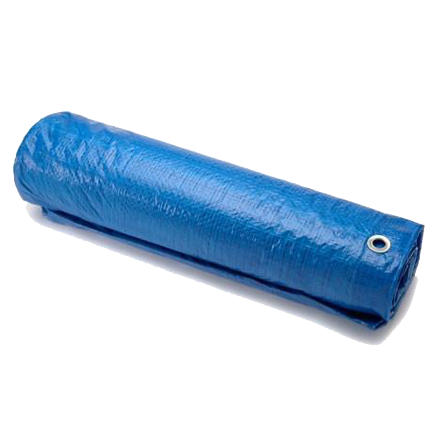Our Guide to Tarps

Our mission is to get people outdoors. Since most people aren't enthusiasts who venture outside regularly, you can buy or rent tarps. Specifically, about our tarp rentals:
- We offer a rent-to-buy program so you don't have to worry about losing money from renting
- Our self-service allows you to hire tarps whenever is convenient for you
Core function: There's not a core function for tarps, because they are one of the most versatile pieces of gear, check the Usage section for ideas. Note, when we say tarp, we do not mean tarp tents (see Other Products on the Market section of our tent gear guide). We mean the standard, woven, plastic-looking, blue/green/black colored tarps you've probably seen used in any number of ways.
What we carry
For rent only: Standard tarps with the following standard dimensions:
- 6X8ft (1.8X2.4m)
- 8X10ft (2.4X3.0m)
- 10X12ft (3.0X3.7m)
Most people are indifferent to exact dimensions, since even the smallest is quite large. If you have a preference or just want to try different sizes, when renting a tarp, you can write-in your preference on the last page.
What to use & how to choose
Sometimes it's easy to get lost in all the hype of something new (over-spending often happens on features). Our guide focuses on the fundamental factors you should always keep in mind (thus, this short list is similar across all items). Then only at the end do we have some questions to get you thinking about other minor features. Also take advantage of renting tarps to try out what works for you!
Make sure your tarp is large enough for whatever purpose you will use it for. If you're not sure, try hiring tarps of different sizes! When using a tarp as a footprint, make sure it is folded to be roughly 2in (5cm) smaller on all sides compared to the tent body's floor side, in other words, the tarp should not poke out beyond the tent floor. If it pokes out or is too large, it can collect water, that then pools underneath the tent. Of course if you fold it too small, it won't protect enough of the floor.
Here, we give you a list of questions to start thinking about other features. We hope our approach of savings these features for last gets you to more critically think about what you need & not get caught up in the hype of what's cool and over-spend your budget. Remember, we allow you to hire a tarp so feel free to try out various models with different features.
- How many grommets does it have & where are they placed?
Usage tips
Tarps are so versatile, here are some ideas!
- As a footprint or ground cloth for your tent: (note if you rent from us, a footprint or tarp will always be included). When using a tarp as a footprint, make sure it is folded to be roughly 2in (5cm) smaller on all sides compared to the tent body's floor side, in other words, the tarp should not poke out beyond the tent floor. If it pokes out or is too large, it can collect water, that then pools underneath the tent. Of course if you fold it too small, it won't protect enough of the floor.
- Spread on the ground for a clean, dry surface: picnic-style to replace a chair or table. For even more comfort, put a blanket over the tarp!
- String from vertical poles or trees as a makeshift shade structure: bring enough cord so you can accommodate any tree layout
- Use as a water protection: drape over your stuff to keep it dry. Tarps are generally at least water repellant. When you use it as water protection, make sure it has not been used previously as a ground cover, since that could create lots of small holes that compromise water resistance (for this reason, our rental tarps shouldn't be used as water protection, since we can't guarantee that people have not used them on the ground). If you're using a tarp as rain protection for a tent it's best to string it up over the tent using nearby trees or vertical poles, like an umbrella. It's not as good of an idea to drape the tarp over your tent like a rainfly, because it's not cut to the shape & contours of your tent, so draping could leave lots of unprotected areas. Not to mention without the right structural support, a tarp could trap condensation or allow water transference from the exterior. See Usage section of our tent gear guide for more info.
- As a tablecloth: alas sometimes picnic tables are well-decorated with lots of... bird droppings
Maintenance tips
Repairing
The info below is for a standard tarp that we carry. For tarp tents, check the gear guide on tents, and the Other Products on the Market section
We can either provide parts or repair services (and discounts on renting tarp while you wait) for the following issues:
- Grommets
- Holes, rips, or tears
Waterproofing: Repairing issues with waterproofing requires careful diagnosis of exactly what the problem is. We have a list of visual cues & solutions in our guide on waterproofing
Cleaning & Storing
Gear not in use should be cleaned & dried and then stored loose & in a dark environment, check out our entire protip on the topic here.
We have a general protip on how to store & maintain gear that we highly recommend reviewing as well. If you send us video or a good photo series, we may be able to help you evaluate your repair needs.
The exact numbers (e.g., weights, dimensions, prices, etc.) used were updated as of September 2019 .